
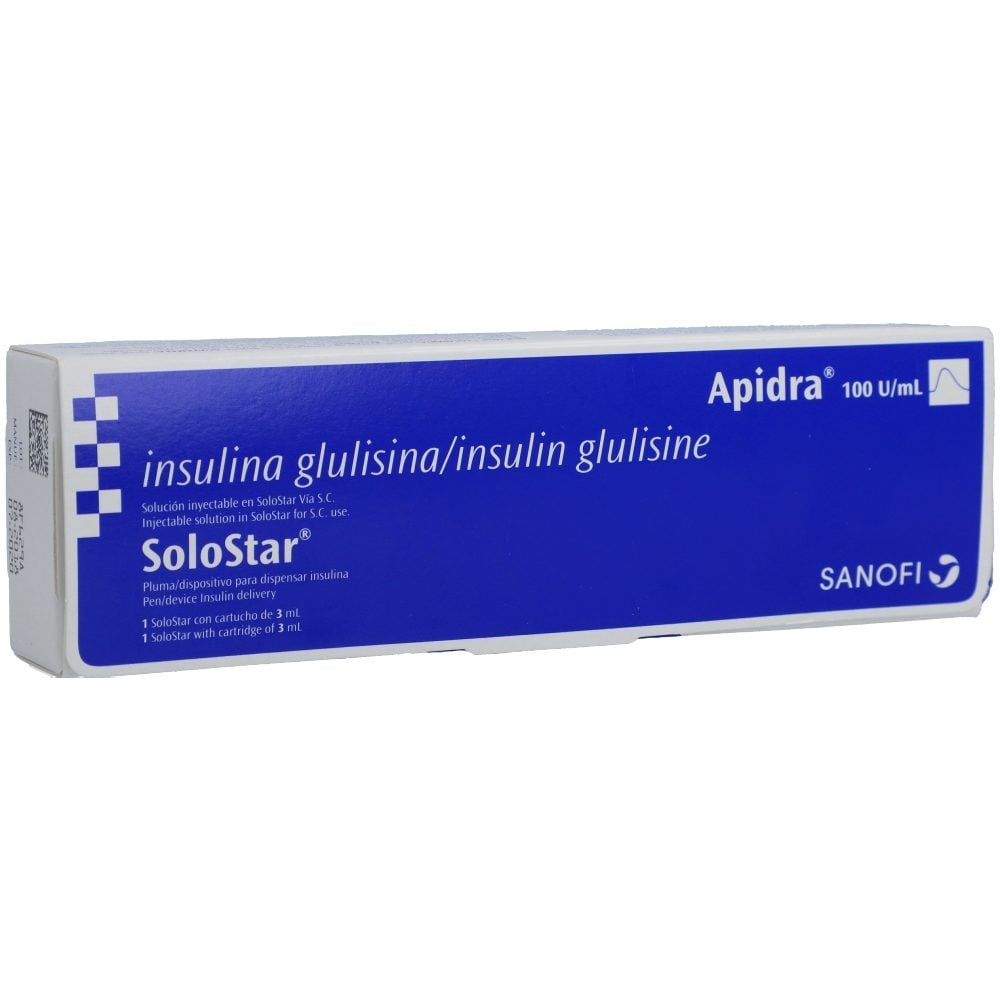
АПИДРА 100 ЕД/мл, СолоСтар раствор для инъекций в предварительно заполненной ручке

Спросите врача о рецепте на АПИДРА 100 ЕД/мл, СолоСтар раствор для инъекций в предварительно заполненной ручке

Инструкция по применению АПИДРА 100 ЕД/мл, СолоСтар раствор для инъекций в предварительно заполненной ручке
Введение
Прошпект: информация для пользователя
Апидра Соло Стар100 Единиц/мл раствор для инъекций в предварительно заполненной ручке
Инсулин глулисин
Прочитайте внимательно весь прошпект и инструкции по применению Апидры Соло Стар, предварительно заполненной ручки, прежде чем начать использовать это лекарство, поскольку оно содержит важную информацию для вас.
- Сохраните этот прошпект, поскольку вам может потребоваться прочитать его снова.
- Если у вас есть какие-либо вопросы, проконсультируйтесь с вашим врачом, фармацевтом или медсестрой.
- Это лекарство было назначено только вам, и не передавайте его другим людям, даже если у них есть те же симптомы, поскольку оно может нанести им вред.
- Если вы испытываете побочные эффекты, проконсультируйтесь с вашим врачом, фармацевтом или медсестрой, даже если это побочные эффекты, которые не указаны в этом прошпекте. См. раздел 4.
Содержание прошпекта
- Что такое Апидра и для чего она используется
- Что вам нужно знать перед началом использования Апидры
- Как использовать Апидру
- Возможные побочные эффекты
- Хранение Апидры
- Содержание упаковки и дополнительная информация
1. Что такое Апидра и для чего она используется
Апидра является антидиабетическим средством, используемым для снижения высокого уровня сахара в крови у пациентов с сахарным диабетом. Она может быть назначена взрослым, подросткам и детям от 6 лет. Сахарный диабет - это заболевание, при котором ваш организм не производит достаточно инсулина для контроля уровня сахара в крови.
Она получена методами биотехнологии. Имеет быстрое начало действия в течение 10-20 минут и короткую продолжительность действия, примерно 4 часа.
2. Что вам нужно знать перед началом использования Апидры
Не используйте Апидру
- Если вы аллергичны к инсулину глулисину или любому другому компоненту этого лекарства (указанному в разделе 6).
- Если ваш уровень сахара слишком низок (гипогликемия), следуйте руководству по гипогликемии (см. рамку в конце этого прошпекта).
Предостережения и меры предосторожности
Апидра в предварительно заполненной ручке показана только для подкожного введения (см. также раздел 3). Проконсультируйтесь с вашим врачом, если вам необходимо вводить инсулин другим методом.
Проконсультируйтесь с вашим врачом, фармацевтом или медсестрой перед началом использования Апидры.
Следуйте внимательно инструкциям по дозировке, контролю (анализам крови), диете и физической активности (физическому труду и упражнениям) так, как указал ваш врач.
Особые группы пациентов
Если у вас есть проблемы с печенью или почками, проконсультируйтесь с вашим врачом, поскольку вам может потребоваться более низкая доза.
Нет достаточной клинической информации об использовании Апидры у детей младше 6 лет.
Изменения кожи в месте инъекции.
Необходимо менять место инъекции, чтобы избежать изменений кожи, таких как уплотнения под кожей. Инсулин может не работать очень хорошо, если вводится в уплотненную зону (см. Как использовать Апидру). Свяжитесь с вашим врачом, если вы сейчас вводите инсулин в уплотненную зону, прежде чем начать вводить в другую зону. Ваш врач может указать вам проверить уровень сахара в крови более часто и отрегулировать инсулин или дозу других антидиабетических препаратов.
Путешествия
Прежде чем отправиться в путешествие, проконсультируйтесь с вашим врачом. Вам может потребоваться проконсультироваться о
- доступности вашей инсулины в стране, которую вы собираетесь посетить,
- запасах инсулины, игл и т. д.,
- правильном хранении инсулины во время путешествия,
- графике приема пищи и введения инсулины во время путешествия,
- возможных эффектах смены часовых поясов,
- возможных новых рисках для здоровья в странах, которые вы собираетесь посетить,
- том, что делать в ситуациях экстренного характера, когда вы чувствуете себя плохо или заболеваете.
Заболевания и травмы
Управление вашим диабетом может потребовать особого ухода в следующих ситуациях:
- Если вы больны или получили серьезную травму, ваш уровень сахара в крови может повыситься (гипергликемия).
- Если вы не едите достаточно, уровень сахара в крови может снизиться слишком сильно (гипогликемия).
В большинстве случаев вам потребуется врач. Убедитесь, что вы проконсультировались с врачом немедленно.
Если у вас диабет 1-го типа (инсулинозависимый диабет), не прекращайте вводить инсулин и не прекращайте принимать достаточное количество углеводов. Сообщите всегда людям, которые занимаются вашим уходом или лечением, что вам нужна инсулин.
Некоторые пациенты с диабетом 2-го типа и сердечно-сосудистыми заболеваниями или инсультом, которые были лечены пиоглитазоном и инсулином, испытывали развитие сердечной недостаточности. Сообщите вашему врачу как можно скорее, если вы испытываете симптомы сердечной недостаточности, такие как необычная одышка или быстрое увеличение веса или локализованная отечность (отек).
Использование Апидры с другими препаратами
Некоторые препараты могут вызывать изменения уровня сахара в крови (повышение, снижение или оба, в зависимости от ситуации). В каждом случае может потребоваться коррекция дозы инсулина, чтобы избежать слишком низких или слишком высоких уровней сахара в крови. Будьте осторожны, когда начинаете принимать другой препарат, и когда прекращаете его принимать.
Сообщите вашему врачу или фармацевту, если вы принимаете, недавно принимали или можете принимать другие препараты. Спросите вашего врача, прежде чем принимать препарат, может ли он повлиять на уровень сахара в крови, и какие меры вам необходимо принять.
Среди препаратов, которые могут вызывать снижение уровня сахара в крови (гипогликемию), включены:
- все другие препараты для лечения диабета,
- ингибиторы ангиотензин-превращающего фермента (АПФ) (используемые для лечения некоторых сердечно-сосудистых заболеваний или гипертонии),
- дисопирамид (используемый для лечения некоторых сердечно-сосудистых заболеваний),
- флуоксетин (используемый для лечения депрессии),
- фибраты (используемые для снижения высоких уровней липидов в крови),
- ингибиторы моноаминоксидазы (МАО) (используемые для лечения депрессии),
- пентоксифиллин, пропоксифен, салицилаты (такие как аспирин, используемый для облегчения боли и лихорадки),
- антибиотики группы сульфаниламидов.
Среди препаратов, которые могут вызывать повышение уровня сахара в крови (гипергликемию), включены:
- кортикостероиды (такие как "кортизон" для лечения воспаления),
- даназол (препарат, влияющий на овуляцию),
- диазоксид (используемый для лечения гипертонии),
- диуретики (используемые для лечения гипертонии и избыточной задержки жидкости),
- глюкагон (поджелудочная гормон, используемый для лечения тяжелой гипогликемии),
- изониазид (используемый для лечения туберкулеза),
- эстрогены и прогестагены (такие как противозачаточные таблетки, используемые для контроля над рождаемостью),
- производные фенотиазина (используемые для лечения психиатрических расстройств),
- соматотропин (гормон роста),
- симпатомиметические препараты (такие как адреналин, сальбутамол, тербуталин, используемые для лечения астмы),
- гормоны щитовидной железы (используемые для лечения расстройств щитовидной железы),
- ингибиторы протеазы (используемые для лечения ВИЧ),
- атипичные антипсихотические препараты (такие как клозапин и оланзапин).
Ваш уровень сахара в крови может повыситься или снизиться, если вы принимаете:
- бета-блокаторы (используемые для лечения гипертонии),
- клонидин (используемый для лечения гипертонии),
- соли лития (используемые для лечения психиатрических расстройств).
Пентамидина (используемая для лечения некоторых инфекций, вызванных паразитами) может вызывать гипогликемию, которая иногда может быть за ней гипергликемией.
Бета-блокаторы, как и другие симпатомиметические препараты (такие как клонидин, гуанетидин и резерпин), могут уменьшать или полностью устранять первые предупреждающие симптомы, которые могут помочь вам распознать гипогликемию.
Если вы не уверены, принимаете ли вы какой-либо из этих препаратов, спросите вашего врача или фармацевта.
Использование Апидры с алкоголем
Ваши уровни сахара в крови могут повыситься или снизиться, если вы употребляете алкоголь.
Беременность и лактация
Если вы беременны или в период лактации, считаете, что можете быть беременной или планируете стать беременной, проконсультируйтесь с вашим врачом или фармацевтом перед использованием этого препарата.
Сообщите вашему врачу, если вы планируете стать беременной или если вы уже беременны. Ваша доза инсулина может потребовать коррекции во время беременности и после родов. Тщательный контроль диабета и предотвращение гипогликемии важны для здоровья вашего ребенка.
Нет данных или они ограничены относительно использования Апидры у беременных женщин.
Если вы в период лактации, проконсультируйтесь с вашим врачом, поскольку вам может потребоваться коррекция дозы инсулина и диеты.
Вождение и использование машин
Ваша способность концентрироваться или реагировать может быть снижена, если:
- у вас гипогликемия (низкий уровень сахара в крови),
- у вас гипергликемия (высокий уровень сахара в крови).
Будьте осторожны с этой возможной проблемой, учитывая все ситуации, которые могут быть причиной риска для вас или других (таких как вождение транспортного средства или использование машин).
Вы должны попросить вашего врача, чтобы он посоветовал вам о способности управлять транспортным средством, если:
- у вас частые эпизоды гипогликемии,
- снижены или не появляются первые предупреждающие симптомы, которые могут помочь вам распознать гипогликемию.
Важная информация о некоторых компонентах Апидры
Этот препарат содержит менее 1 ммоль (23 мг) натрия на дозу, что означает, что он практически не содержит натрия.
Апидра содержит метакрезол
Апидра содержит метакрезол, который может вызывать аллергические реакции.
3. Как использовать Апидру
Доза
Следуйте точно инструкциям по введению этого препарата, указанным вашим врачом. В случае сомнений проконсультируйтесь снова с вашим врачом или фармацевтом.
Ваш врач также определит дозу Апидры, которую вам необходимо в зависимости от вашего образа жизни и результатов контроля сахара (глюкозы) в крови и предыдущего лечения инсулином.
Апидра является инсулином короткого действия. Ваш врач может указать вам использовать ее в комбинации с инсулином среднего или длительного действия, базальной инсулином или таблетками, используемыми для лечения высоких уровней сахара в крови.
Если вы переходите с другой инсулины на инсулин глулисин, ваша доза может потребовать коррекции вашим врачом.
Многие факторы могут влиять на ваш уровень сахара в крови. Вам необходимо знать эти факторы, чтобы правильно реагировать на изменения уровня сахара в крови и избежать слишком высоких или слишком низких уровней. См. рамку в конце прошпекта для получения более подробной информации.
Способ введения
Апидра вводится под кожу (подкожно).
Ваш врач покажет вам, в какой области кожи необходимо вводить Апидру. Апидра может быть введена в брюшную стенку, бедро или верхнюю часть руки или путем непрерывной инфузии в брюшную стенку. Эффект будет немного быстрее, если инсулин будет введен в живот. Как и с другими инсулинами, места инъекции и инфузии внутри одной области инъекции (брюшная стенка, бедро или верхняя часть руки) должны меняться от одной инъекции к другой.
Частота введения
Апидра должна быть введена незадолго до или незадолго после еды.
Инструкции по правильному использованию
Как обращаться с Соло Стар
Соло Стар - это одноразовая предварительно заполненная ручка, содержащая инсулин глулисин. Апидра в предварительно заполненной ручке показана только для подкожного введения. Проконсультируйтесь с вашим врачом, если вам необходимо вводить инсулин другим методом.
Внимательно прочитайте "Инструкции по использованию Соло Стар", включенные в этот прошпект. Вы должны использовать ручку так, как описано в этих инструкциях.
Чтобы предотвратить возможную передачу заболевания, каждая ручка должна быть использована только одним пациентом.
Прежде чем использовать ручку, всегда вставляйте новую иглу и проводите тест безопасности. Используйте только иглы, совместимые с Соло Стар (см. "Инструкции по использованию Соло Стар").
Осмотрите запечатанный картридж в ручке-инъекторе перед использованием. Его можно использовать только если раствор прозрачный, бесцветный и не содержит видимых частиц. Не встряхивайте и не смешивайте перед использованием.
Используйте всегда новую ручку, если вы заметили, что ваш контроль сахара в крови ухудшился без объяснимой причины. Если вы думаете, что у вас есть проблема с Соло Стар, пожалуйста, проконсультируйтесь с вашим медицинским специалистом.
Если вы использовали больше Апидры, чем необходимо
- Если вы ввели слишком много Апидры, ваш уровень сахара в крови может стать очень низким (гипогликемия).
Проверяйте ваш уровень сахара в крови часто. В целом, чтобы предотвратить гипогликемию, вам необходимо есть больше и контролировать уровень сахара в крови. Для получения более подробной информации о лечении гипогликемии см. рамку в конце прошпекта.
Если вы забыли использовать Апидру
- Если вы забыли принять дозу Апидры или если вы не ввели достаточно инсулина, ваш уровень сахара в крови может повыситься сильно (гипергликемия). Проверяйте ваш уровень сахара в крови часто. Для получения более подробной информации о лечении гипергликемии см. рамку в конце прошпекта.
- Не используйте двойную дозу, чтобы компенсировать пропущенные дозы.
Если вы прервете лечение Апидрой
Это может привести к тяжелой гипергликемии (очень высоким уровням сахара в крови) и кетоацидозу (повышению кислотности крови, поскольку организм расщепляет жиры вместо сахара). Не прерывайте лечение Апидрой без консультации с вашим врачом; он скажет вам, что делать.
Если у вас есть какие-либо другие вопросы о использовании этого препарата, спросите вашего врача, фармацевта или медсестру.
Перепутывание инсулинов
Вы должны всегда проверять этикетку инсулина перед каждой инъекцией, чтобы избежать перепутывания Апидры с другими инсулинами.
4. Возможные побочные эффекты
Как и все лекарства, это лекарство может вызывать побочные эффекты, хотя не все люди испытывают их.
Тяжелые побочные эффекты
Гипогликемия (низкий уровень сахара в крови) может быть очень тяжелой.Гипогликемия - это побочный эффект, наблюдаемый очень часто (может затронуть более 1 из 10 пациентов).
Гипогликемия (низкий уровень сахара в крови) означает, что у вас не достаточно сахара в крови.Если ваш уровень сахара в крови снизится слишком сильно, вы можете потерять сознание. Тяжелая гипогликемия может привести к повреждению мозга и может быть опасной для жизни. Если у вас есть симптомы низкого уровня сахара в крови, действуйте немедленно, чтобы повысить уровень сахара в крови. См. рамку в конце этого прошпекта, где вы найдете более важную информацию о гипогликемии и ее лечении.
Если вы испытываете следующие симптомы, свяжитесь немедленно с вашим врачом:
Системные аллергические реакции- это побочные эффекты, наблюдаемые редко (могут затронуть до 1 из 100 пациентов).
Аллергия к инсулину:связанные симптомы могут включать кожные реакции в крупном масштабе (сыпь и зуд по всему телу), сильную отечность кожи или слизистых оболочек (ангиоэдема), затруднение дыхания, снижение артериального давления с быстрым сердечным ритмом и потоотделением. Это могут быть симптомы тяжелых случаев аллергии к инсулину, включая анафилактическую реакцию, которая может быть опасной для жизни.
Гипергликемия (высокий уровень сахара в крови) означает, что в крови слишком много сахара.
Частота гипергликемии не может быть оценена. Если ваш уровень сахара в крови слишком высок, это означает, что вам может потребоваться больше инсулина, чем было введено. Это может быть серьезно, если ваш уровень сахара в крови станет очень высоким.
Для получения более подробной информации о симптомах и признаках гипергликемии см. рамку в конце этого прошпекта.
Другие побочные эффекты
- Изменения кожи в месте инъекции.
Если инсулин вводится слишком часто в одно и то же место, жировая ткань может уменьшиться (липоатрофия) или стать более толстой (липогипертрофия) (может затронуть до 1 из 1000 человек). Бугорки под кожей также могут возникнуть из-за накопления белка, называемого амилоидом (амилоидоз кожи; неизвестна частота). Инсулин может не работать очень хорошо, если вводится в уплотненную зону. Меняйте место инъекции, чтобы помочь избежать этих изменений кожи.
Частые побочные эффекты(могут затронуть до 1 из 10 пациентов)
- Аллергические реакции и кожные реакции в месте инъекции
Могут возникнуть реакции в месте инъекции (такие как покраснение, сильная боль, зуд, крапивница, отек или воспаление). Эти реакции также могут распространиться вокруг места инъекции. Большинство легких реакций на инсулин обычно разрешаются в течение нескольких дней или недель.
Побочные эффекты, частота которых не может быть оценена на основе доступных данных
- Глазные реакции
Значительное изменение (улучшение или ухудшение) контроля уровня сахара в крови может привести к временному ухудшению зрения. Если у вас есть пролиферативная ретинопатия (заболевание глаз, связанное с диабетом), тяжелые гипогликемические приступы могут привести к временной потере зрения.
Сообщение о побочных эффектах
Если вы испытываете любой побочный эффект, свяжитесь с вашим врачом, фармацевтом или медсестрой, даже если это возможные побочные эффекты, которые не указаны в этом прошпекте. Вы также можете сообщить об этом напрямую через национальную систему уведомления, включенную в приложение V. Сообщая о побочных эффектах, вы можете внести свой вклад в предоставление более подробной информации о безопасности этого препарата.
5. Хранение Апидры
Храните это лекарство в недоступном для детей месте.
Не используйте это лекарство после даты истечения срока годности, указанной на упаковке и на этикетке ручки после обозначения CAD/EXP. Дата истечения срока годности - последний день указанного месяца.
Неиспользованные ручки
Хранить в холодильнике (при температуре между 2°C и 8°C).
Не замораживать.
Не размещать SoloStar рядом с отделением морозильника или рядом с охлаждающим устройством.
Хранить предзаряженную ручку в наружной упаковке, чтобы защитить ее от света.
Ручки в использовании
Предзаряженные ручки в использовании (или для ношения в качестве запаса) можно хранить не более 4 недель при температуре ниже 25°C и защищать от прямого тепла или прямого света. Ручка в использовании не должна храниться в холодильнике.
Не используйте ее после этого периода времени.
Не используйте это лекарство, если оно не бесцветное и прозрачное.
Лекарства не должны выбрасываться в канализацию или в мусор. Спросите у вашего фармацевта, как избавиться от упаковок и лекарств, которые вам больше не нужны. Таким образом, вы поможете защитить окружающую среду.
6. Содержание упаковки и дополнительная информация
Состав Апидры
- Активное вещество - инсулин глулисин. Каждый мл раствора содержит 100 ЕД инсулина глулисина (что эквивалентно 3,49 мг).
- Другие компоненты: метакрезол (см. раздел 2 «Апидра содержит метакрезол»), хлорид натрия (см. раздел 2 «Важная информация о некоторых компонентах Апидры»), трометамол, полисорбат 20, концентрированная соляная кислота, гидроксид натрия, вода для инъекционных препаратов.
Внешний вид продукта и содержание упаковки
Апидра SoloStar 100 ЕД/мл раствор для инъекций в предварительно заполненной笔е. Это прозрачный, бесцветный водный раствор без видимых частиц.
Каждая笔а содержит 3 мл раствора, что эквивалентно 300 ЕД. Существуют упаковки из 1, 3, 4, 5, 6, 8, 9 и 10 предварительно заполненных笔. Возможно, что не все размеры упаковок будут продаваться.
Владелец разрешения на продажу и ответственное лицо за производство
Владелец разрешения на продажу:
Sanofi-Aventis Deutschland GmbH
D-65926 Франкфурт-на-Майне
Германия
Ответственное лицо за производство:
Sanofi-Aventis Deutschland GmbH
Промышленный парк Хёхст, D-65926 Франкфурт
Германия
Вы можете запросить дополнительную информацию о этом лекарстве, обратившись к местному представителю владельца разрешения на продажу.
Бельгия/Белгие/Бельгия Sanofi Belgium Тел.: +32 (0)2 710 54 00 | Люксембург/Люксембург Sanofi Belgium Тел.: +32 (0)2 710 54 00 (Бельгия/Белгие) |
| Венгрия SANOFI-AVENTIS Zrt. Тел.: +36 1 505 0050 |
Чешская Республика Sanofi s.r.o. Тел.: +420 233 086 111 | Мальта Sanofi S.r.l. Тел.: +39 02 39394275 |
Дания Sanofi A/S Тел.: +45 45 16 70 00 | Нидерланды Sanofi B.V. Тел.: +31 20 245 4000 |
Германия Sanofi-Aventis Deutschland GmbH Тел.: 0800 52 52 010 Тел. из-за рубежа: +49 69 305 21 131 | Норвегия sanofi-aventis Norge AS Тел.: +47 67 10 71 00 |
Эстония Swixx Biopharma OÜ Тел.: +372 640 10 30 | Австрия sanofi-aventis GmbH Тел.: +43 1 80 185 – 0 |
Греция Sanofi-Aventis Μονοπρ?σωπη AEBE Тел.: +30 210 900 16 00 | Польша Sanofi Sp. z o.o. Тел.: +48 22 280 00 00 |
Испания sanofi-aventis, S.A. Тел.: +34 93 485 94 00 | Португалия Sanofi - Produtos Farmacêuticos, Lda. Тел.: +351 21 35 89 400 |
Франция Sanofi Winthrop Industrie Тел.: 0 800 222 555 Звонок из-за рубежа: +33 1 57 63 23 23 Хорватия Swixx Biopharma d.o.o. Тел.: +385 1 2078 500 | Румыния Sanofi Romania SRL Тел.: +40 (0) 21 317 31 36 |
Ирландия sanofi-aventis Ireland Ltd. T/A SANOFI Тел.: +353 (0) 1 403 56 00 | Словения Swixx Biopharma d.o.o. Тел.: +386 1 235 51 00 |
Исландия Vistor hf. Тел.: +354 535 7000 | Словакия Swixx Biopharma s.r.o. Тел.: +421 2 208 33 600 |
Италия Sanofi S.r.l. Тел.: 800 13 12 12 (технические вопросы) 800 536389 (другие вопросы) | Финляндия Sanofi Oy Тел.: +358 (0) 201 200 300 |
Кипр C.A. Papaellinas Ltd. Тел.: +357 22 741741 | Швеция Sanofi AB Тел.: +46 (0)8 634 50 00 |
Латвия Swixx Biopharma SIA Тел.: +371 6 616 47 50 | Великобритания(Северная Ирландия) sanofi-aventis Ireland Ltd. T/A SANOFI Тел.: +44 (0) 800 035 2525 |
Литва Swixx Biopharma UAB Тел.: +370 5 236 91 40 |
Дата последнего пересмотра этой инструкции:
Другой источник информации
Подробная информация о этом лекарстве доступна на сайте Европейского агентства по лекарственным средствам: http://www.ema.europa.eu/
ГИПЕРГЛИКЕМИЯ И ГИПОГЛИКЕМИЯ
Всегда носите с собой немного сахара (не менее 20 граммов).
Носите с собой некоторую информацию, которая указывает на то, что вы диабетик.
ГИПЕРГЛИКЕМИЯ (высокие уровни сахара в крови)
Если у вас очень высокий уровень сахара в крови (гипергликемия), вы, возможно, не ввели достаточно инсулина.
Почему возникает гипергликемия?
Некоторые примеры:
- вы не ввели инсулин или не ввели достаточное количество, или если его действие уменьшилось, например, из-за неправильного хранения,
- вы делаете меньше упражнений, чем обычно, испытываете стресс (эмоциональное напряжение, возбуждение) или страдаете от травмы, операции, инфекции или лихорадки,
- вы принимаете или принимали определенные лекарства (см. раздел 2, «Применение Апидры с другими лекарствами»).
Симптомы предупреждения о гипергликемии
Жажда, увеличение потребности в мочеиспускании, усталость, сухость кожи, покраснение лица, потеря аппетита, низкое кровяное давление, быстрое сердцебиение и присутствие глюкозы и кетоновых тел в моче. Боль в животе, глубокое и быстрое дыхание, сонливость или даже потеря сознания могут быть признаками серьезного состояния (кetoацидоз) из-за недостатка инсулина.
Что делать в случае гипергликемии?
Вы должны проанализировать уровень сахара в крови и уровень ацетона в моче как можно скорее после появления любого из вышеуказанных симптомов. Гипергликемия или кетоацидоз должны быть всегда лечены врачом, обычно в больнице.
ГИПОГЛИКЕМИЯ (низкие уровни сахара в крови)
Если уровень сахара в крови слишком низок, вы можете потерять сознание. Серьезная гипогликемия может привести к сердечному приступу или повреждению мозга и может поставить под угрозу вашу жизнь. Обычно вы должны быть в состоянии распознать, когда уровень сахара в крови слишком низок, чтобы принять соответствующие меры.
Почему возникает гипогликемия?
Некоторые примеры:
- вы ввели слишком много инсулина,
- пропустили приемы пищи или отложили их,
- не съели достаточно, или съели продукты, содержащие меньше углеводов, чем обычно (сахар и подобные ему вещества называются углеводами; однако, искусственные подсластители не являются углеводами),
- потеряли углеводы из-за рвоты или диареи,
- употребили алкоголь, особенно если не ели много,
- занимались больше физической активностью, чем обычно, или другим типом физической активности,
- восстанавливались после травмы, операции или других видов стресса,
- восстанавливались после болезни или лихорадки,
- принимали или перестали принимать определенные лекарства (см. раздел 2, «Применение Апидры с другими лекарствами»).
Также более вероятно, что произойдет гипогликемия, если:
- вы только что начали лечение инсулином или изменили препарат инсулина,
- уровни сахара в крови почти нормальные или нестабильные,
- изменили место инъекции инсулина (например, с бедра на верхнюю часть руки),
- страдаете тяжелой болезнью почек или печени, или другой болезнью, такой как гипотиреоз.
Симптомы предупреждения о гипогликемии
- В вашем теле
Примеры симптомов, которые указывают на то, что уровень сахара в крови слишком низок: пот, влажная и липкая кожа, тревога, быстрое сердцебиение, высокое кровяное давление, перебои в сердечном ритме и нерегулярное сердцебиение. Эти симптомы часто появляются до появления симптомов низкого уровня сахара в мозге.
- В вашем мозге
Примеры симптомов, которые указывают на низкий уровень сахара в мозге: головные боли, сильный голод, тошнота, рвота, усталость, сонливость, нарушения сна, беспокойство, агрессивное поведение, нарушения концентрации внимания, измененные реакции, депрессия, путаница, нарушения речи (иногда, полная потеря речи), нарушения зрения, тремор, паралич, ощущения онемения и покалывания (парестезии), ощущения онемения и покалывания в области рта, головокружение, потеря самообладания, неспособность заботиться о себе, судороги и потеря сознания.
Первые симптомы предупреждения о гипогликемии («симптомы предупреждения») могут измениться, уменьшиться или отсутствовать полностью, если:
- вы пожилой человек,
- вы страдаете диабетом в течение долгого времени,
- вы страдаете определенным типом нервного заболевания (диабетическая автономная нейропатия),
- вы недавно пережили эпизод гипогликемии (например, вчера) или если она развивается постепенно,
- у вас почти нормальные или, по крайней мере, очень улучшенные уровни сахара в крови,
- вы принимаете или принимали определенные лекарства (см. раздел 2, «Применение Апидры с другими лекарствами»).
В этом случае вы можете развить серьезную гипогликемию (и даже потерять сознание) до того, как осознаете проблему. Всегда знакомьтесь со своими симптомами предупреждения. Если необходимо, более частый анализ сахара в крови может помочь выявить легкие эпизоды гипогликемии, которые в противном случае могли бы остаться незамеченными. Если вы не уверены, что можете распознать свои симптомы предупреждения, избегайте ситуаций (например, вождения автомобиля), которые могут поставить под угрозу вас или других людей в результате гипогликемии.
Что делать, если вы испытываете гипогликемию?
- Не вводите инсулин. Сразу же принимайте 10-20 граммов сахара, такой как глюкоза, сахарные кубики или сладкий напиток. Примечание: искусственные подсластители и продукты с искусственными подсластителями вместо сахара (например, диетические напитки) не помогут при лечении гипогликемии.
- После этого съешьте что-то, что имеет длительное действие на повышение уровня сахара в крови (например, хлеб или макароны). Ваш врач или медсестра должны были обсудить это с вами.
- Если гипогликемия повторяется, принимайте еще 10-20 граммов сахара.
- Немедленно проконсультируйтесь с врачом, если вы не можете контролировать гипогликемию или если она повторяется.
Сообщите своим близким, друзьям и знакомым следующее:
Если вы не можете глотать или теряете сознание, вам понадобится инъекция глюкозы или глюкагона (лекарство, которое увеличивает уровень сахара в крови). Эти инъекции оправданы, даже если вы не уверены, что страдаете гипогликемией.
Рекомендуется проанализировать уровень сахара в крови сразу после приема глюкозы, чтобы подтвердить, что вы действительно страдаете гипогликемией.
Апидра SoloStar раствор для инъекций в предварительно заполненной笔е. ИНСТРУКЦИИ ПО ПРИМЕНЕНИЮ
SoloStar - это предварительно заполненная笔а для инъекции инсулина. Ваш врач решил, что SoloStar подходит для вас на основе вашей способности обращаться с SoloStar. Перед использованием SoloStar проконсультируйтесь с вашим врачом, фармацевтом или медсестрой о правильной технике инъекции.
Прочитайте эти инструкции внимательно перед использованием вашей SoloStar. Если вы не обучены использовать SoloStar или следовать полностью этим инструкциям самостоятельно, вы должны использовать SoloStar только с помощью человека, который может следовать полностью этим инструкциям. Держите笔у так, как показано в этом листке. Чтобы убедиться, что вы правильно читаете дозу, держите笔у горизонтально, с иглой слева и селектором дозы справа, как показано на рисунке ниже.
Вы можете устанавливать дозы от 1 до 80 единиц с шагом 1 единица. Каждая笔а содержит несколько доз.
Сохраните этот листок для будущего справочного материала.
Если у вас есть какие-либо вопросы о SoloStar или диабете, проконсультируйтесь с вашим врачом, фармацевтом или медсестрой или позвоните по местному телефону sanofi-aventis, указанному на передней части этого листка.



Схема笔ы
Важная информация для использования SoloStar:
- Всегда вставляйте новую иглу перед каждым использованием. Используйте только иглы, совместимые с SoloStar.
- Не устанавливайте дозу и не нажимайте кнопку, если нет вставленной иглы.
- Всегда проводите тест безопасности перед каждой инъекцией (см. Шаг 3).
- Эта笔а предназначена только для вашего использования. Не делитесь ею с кем-либо.
- Если вашу инъекцию выполняет другой человек, необходимо проявлять особую осторожность, чтобы избежать случайного повреждения иглой и передачи инфекций.
- Никогда не используйте SoloStar, если он поврежден или если вы не уверены, что он работает правильно.
- Всегда имейте запасную SoloStar, на случай, если ваша SoloStar потеряна или повреждена.
Шаг 1.Проверка инсулина
- Проверьте этикетку вашей SoloStar, чтобы убедиться, что она содержит правильный инсулин. Апидра SoloStar - синяя. У нее есть темно-синяя кнопка инъекции с выступающим кольцом на конце.
- Удалите колпачок с笔ы.
- Проверьте внешний вид вашего инсулина. Апидра - прозрачный инсулин. Не используйте SoloStar, если инсулин мутный, окрашен или содержит частицы.
Шаг 2.Установка иглы
Всегда используйте новую стерильную иглу для каждой инъекции. Это помогает предотвратить загрязнения и возможные блокировки иглы.
- Удалите защитный чехол с новой иглы.
- Выровняйте иглу с笔ой и держите ее прямо, пока вставляете (завинчивайте или толкайте, в зависимости от типа иглы).
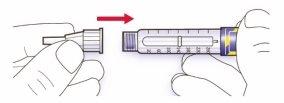
- Если игла не держится прямо, пока вставляется, резиновый уплотнитель может разорваться и привести к утечкам или разрыву иглы.
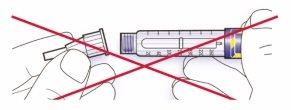
Шаг 3.Тест безопасности
Перед каждой инъекцией всегда проводите тест безопасности. Это гарантирует, что вы получаете точную дозу, поскольку:
- убеждаетесь, что笔а и игла работают идеально
- удаляются пузырьки воздуха
- Установите дозу 2 единицы, поворачивая селектор дозы.
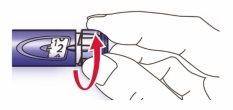
- Удалите внешний защитник иглы и сохраните его, чтобы удалить использованную иглу после каждой инъекции. Удалите внутренний защитник иглы и выбросьте его.

- Держите笔у с иглой, направленной вверх.
- Аккуратно постучите по резервуару инсулина, чтобы пузырьки воздуха поднялись к игле.
- Нажмите кнопку инъекции полностью. Проверьте, что инсулин появляется на конце иглы.
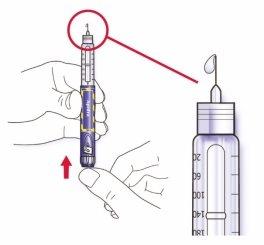
Вы можете провести тест безопасности несколько раз, пока не появится инсулин.
- Если инсулин не появляется, проверьте пузырьки воздуха и повторите тест безопасности дважды, чтобы удалить их.
- Если инсулин все еще не появляется, игла может быть заблокирована. Замените иглу и попробуйте снова.
- Если инсулин не появляется после замены иглы, ваша SoloStar может быть неисправна. Не используйте эту SoloStar.
Шаг 4.Установка дозы
Вы можете устанавливать дозы с шагом 1 единица, от минимальной дозы 1 единица до максимальной дозы 80 единиц. Если вам необходимо более 80 единиц, вам необходимо сделать две или более инъекции.
- Проверьте, что в окне дозы появляется «0» после теста безопасности.
- Установите свою дозу (в следующем примере выбрана доза 30 единиц). Если вы слишком сильно поворачиваете селектор дозы, вы можете вернуться назад.

- Не нажимайте кнопку инъекции, пока поворачиваете, поскольку инсулин может вытечь.
- Вы не можете поворачивать селектор дозы, если количество единиц превышает количество, оставшееся в笔е. Не заставляйте селектор дозы. В этом случае вы можете ввести оставшееся количество в笔е и завершить дозу с новой SoloStar или использовать новую SoloStar для полной дозы.
Шаг 5.Введение дозы
- Используйте метод инъекции, который вам преподали ваш врач, фармацевт или медсестра.
- Вставьте иглу в кожу.
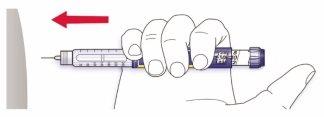
- Освободите дозу, нажав кнопку инъекции полностью. Число, появляющееся в окне дозы, вернется к «0», когда будет введена доза.

uestra 10 segundos">
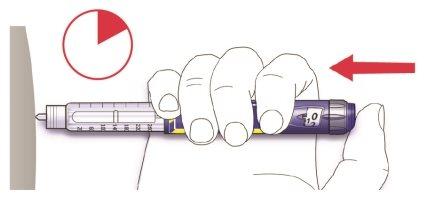
- Держите кнопку инъекции полностью нажатой. Медленно считайте до 10, прежде чем удалить иглу из кожи. Это гарантирует, что будет выпущена полная доза.
Поршень ручки движется с каждой дозой. Поршень достигнет конца картриджа, когда будет использовано общее количество 300 единиц инсулина.
Шаг 6.Удаление и утилизация иглы
После каждой инъекции удалите иглу и сохраните SoloStar без иглы.
Это помогает предотвратить:
- Загрязнения и/или инфекции,
- Вход воздуха в резервуар инсулина и потерю инсулина, которые могут привести к неточной дозе.
- Поместите внешний защитный чехол иглы на иглу и используйте его для отворачивания иглы от ручки. Чтобы уменьшить риск несчастных случаев с иглой, никогда не ставьте обратно внутренний защитный чехол.
- Если ваша инъекция вводится другим человеком или если вы вводите инъекцию другому человеку, вы должны быть особенно осторожны при удалении и утилизации иглы. Следуйте рекомендуемым мерам безопасности для удаления и утилизации игл (обратитесь к вашему врачу, фармацевту или медсестре), чтобы уменьшить риск несчастных случаев с иглой и передачи инфекционных заболеваний.
- Утилизируйте иглу безопасно, как вам показал ваш врач, фармацевт или медсестра.
- Всегда помещайте колпачок ручки после каждой инъекции и храните ручку до следующей инъекции.
Инструкции по хранению
Проверьте обратную сторону этого листка для следования инструкциям по хранению SoloStar.
Если SoloStar хранится в прохладном месте, его необходимо вынуть за 1-2 часа до инъекции, чтобы он достиг комнатной температуры. Инъекция холодного инсулина более болезненна.
SoloStar должен быть утилизирован в соответствии с местными правилами.
Техническое обслуживание
Защитите SoloStar от пыли и грязи.
Вы можете очистить внешнюю часть вашего SoloStar влажной тканью.
Не замачивайте, не мойте и не смазывайте ручку, так как это может ее испортить.
SoloStar предназначен для точной и безопасной работы. С ним необходимо обращаться осторожно. Избегайте ситуаций, в которых SoloStar может быть испорчен. Если вас беспокоит, что ваш SoloStar может быть испорчен, используйте новый.

Сколько стоит АПИДРА 100 ЕД/мл, СолоСтар раствор для инъекций в предварительно заполненной ручке в Испании в 2025 году?
Средняя цена на АПИДРА 100 ЕД/мл, СолоСтар раствор для инъекций в предварительно заполненной ручке в ноябрь, 2025 года составляет около 46.97 евро. Финальная стоимость может зависеть от региона, конкретной аптеки и рецептурного статуса. Для точной информации лучше проверить онлайн или в ближайшей аптеке.
- Страна регистрации
- Средняя цена в аптеках46.97 EUR
- Активное вещество
- Требуется рецептДа
- Производитель
- Информация носит справочный характер и не является медицинской рекомендацией. Перед приемом любых препаратов проконсультируйтесь с врачом. Oladoctor не несет ответственности за медицинские решения, принятые на основе этого контента.
- Аналоги АПИДРА 100 ЕД/мл, СолоСтар раствор для инъекций в предварительно заполненной ручкеФорма выпуска: ИНЪЕКЦИОННЫЙ РАСТВОР, 100 ЕД/млАктивное вещество: инсулина глюлизинаПроизводитель: Sanofi-Aventis Deutschland GmbhТребуется рецептФорма выпуска: ИНЪЕКЦИОННЫЙ РАСТВОР, 100 ЕД/млАктивное вещество: инсулина глюлизинаПроизводитель: Sanofi-Aventis Deutschland GmbhТребуется рецептФорма выпуска: ИНЪЕКЦИОННЫЙ РАСТВОР, 100 ЕД/млАктивное вещество: инсулин человекаПроизводитель: Novo Nordisk A/SТребуется рецепт
Врачи онлайн по АПИДРА 100 ЕД/мл, СолоСтар раствор для инъекций в предварительно заполненной ручке
Консультация по дозировке, побочным эффектам, взаимодействиям, противопоказаниям и продлению рецепта на АПИДРА 100 ЕД/мл, СолоСтар раствор для инъекций в предварительно заполненной ручке – по решению врача и с учетом местных правил.















